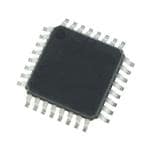ATMEGA168-15A
8-bit microcontrollers with 16KB flash memory for versatile applications
Manufacturer: ['microchip', 'atmel']
series introduction
# ATMEGA168 - 15A Product Series Introduction
## 1. Overview
The ATMEGA168 - 15A is a highly versatile and powerful 8 - bit microcontroller series developed by Microchip Technology. It belongs to the AVR family, which is well - known for its high performance, low power consumption, and rich set of on - chip peripherals. This product series is designed to meet the diverse needs of embedded systems, ranging from simple consumer electronics to complex industrial control applications.
## 2. Key Features
### 2.1 Processor Core
- **AVR RISC Architecture**: The ATMEGA168 - 15A is based on the AVR Reduced Instruction Set Computing (RISC) architecture. This architecture allows for efficient execution of instructions, with most instructions being executed in a single clock cycle. As a result, it can achieve high processing speeds, enabling rapid response to various tasks in the embedded system.
- **16 MHz Clock Frequency**: With a maximum clock frequency of 16 MHz, the microcontroller can perform a large number of operations per second. This high - speed processing capability makes it suitable for applications that require real - time data processing, such as sensor data acquisition and control algorithms implementation.
### 2.2 Memory
- **16 KB Flash Memory**: The on - chip flash memory provides sufficient space to store the program code. This non - volatile memory allows the microcontroller to retain the program even when the power is turned off. Developers can easily update the program code using in - system programming (ISP) or other programming methods, which is very convenient for product development and maintenance.
- **1 KB SRAM**: The static random - access memory (SRAM) is used for storing temporary data during program execution. It provides fast access to data, which is crucial for efficient program operation. The 1 KB of SRAM is sufficient for most medium - sized embedded applications to handle variables, buffers, and intermediate results.
- **512 Bytes EEPROM**: The electrically erasable programmable read - only memory (EEPROM) is used for storing non - volatile data that needs to be retained even after power cycling. It can be used to store configuration parameters, calibration data, or other important information that should not be lost when the power is off.
### 2.3 Peripherals
#### 2.3.1 General - Purpose Input/Output (GPIO)
- The ATMEGA168 - 15A has a total of 23 programmable GPIO pins. These pins can be configured as either input or output pins according to the requirements of the application. They can be used to interface with external devices such as sensors, actuators, displays, and switches. For example, a GPIO pin can be used to read the state of a push - button switch or to control the operation of a relay.
#### 2.3.2 Timer/Counters
- **Three Timer/Counters**: It is equipped with three timer/counter modules, including two 8 - bit timer/counters (Timer0 and Timer2) and one 16 - bit timer/counter (Timer1). These timer/counters can be used for a variety of purposes, such as generating accurate time delays, measuring time intervals, and generating pulse - width modulation (PWM) signals. PWM signals are commonly used in motor control applications to control the speed and direction of motors.
#### 2.3.3 Serial Communication Interfaces
- **Universal Synchronous/Asynchronous Receiver/Transmitter (USART)**: The USART provides a full - duplex serial communication interface, which allows the microcontroller to communicate with other devices such as computers, sensors, and other microcontrollers. It supports both synchronous and asynchronous communication modes, with configurable baud rates, data bits
Images for reference

32-TQFP

AT42QT1111-AU

Image Preview